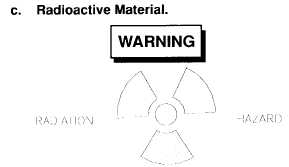|
| |
TM 750-116
HANDLE WITH CARE. IN THE
EVENT THE RADIOLUMINOUS SOURCE
IS BROKEN, CRACKED, OR SUDDENLY
LOSES ILLUMINATION, DO NOT AT-
TEMPT TO REPAIR. IMMEDIATELY
DOUBLE WRAP INSTRUMENT IN PLAS-
TIC AND NOTIFY THE LOCAL RADI-
ATION PROTECTION OFFICER (RPO).
CONTACT THE BASE SAFETY OFFICE
FOR THE NAME AND TELEPHONE
NUMBER OF YOUR LOCAL RPO:
LOCAL RPO:
TELEPHONE:
(1) Safety Procedures for Nuclear Regulatory
Commission (NRC) Licensed Tritium Fire Control
Devices.
(a) Purpose: To implement mandatory license re-
quirements for use and maintenance of tritium radiolumi-
nous fire control instruments used on howitzers, mortars,
tanks, and rifles.
(b) Scope: This procedure is applicable to all person-
nel working with tritium devices, including organizational,
direct support, general support maintenance and operator
levels.
(c) Radiological Hazard: The beta radiation
emitted by tritium presents no external radiation hazard.
However, if taken internally, it can damge soft tissue. If a
capsule is broken, the tritium gas will dissipate into the sur-
rounding air and surfaces near the vicinity of the break may
become contaminated. Tritium can be taken into the body
by inhalation, ingestion, or percutaneous (skin) absorption/
injection.
(2) Safety Precautions.
(a) Check for illumination in low light or darkroom
prior to use or service. If not illuminated, do not repair.
Double wrap the entire instrument in plastic (item 1, appx
B) and notify the local RPO.
(b) Removal of the radioluminous source from the
instrument is prohibited except at authorized depots. No
eating, drinking, smoking or applying cosmetics will be
allowed in tritium device work areas.
(3) Emergency Procedures. If a tritium source
breaks, inform other personnel to vacate the area or move
upwind. If skin contact is made with any area contaminated
with tritium, wash immediately with nonabrasive soap and
water. Report the incident to the local RPO. Actions below
will be taken under supervision or direction of the local
RPO.
(a) Personnel handling the instrument should wear
rubber or latex gloves. Instrument must be immediately
double wrapped in plastic (item 1, appx B), sealed, pack-
aged and evacuated to depot. Outside package must be
identified as "Broken Tritium Device - Do Not Open."
Dispose of used gloves as radioactive waste per instructions
from local RPO and wash hands well.
(b) Personnel who may have handled the broken
tritium instrument should report to health clinic for tritium
bioassay. Optimum bioassay sample is at least four hours
after exposure.
(c) Broken tritium sources indoors may result in
tritium contamination in the area, such as workbench or
table. The area must be cordoned off, restricted until wipe
tests indicate no contamination.
(4) Further Information.
(a) Requirements for safe handling, maintenance,
storage and training are located in TM 9-254, General
Maintenance Procedures for Fire Control Materiel.
(b) If assistance is needed, contact your local or ma-
jor command (MACOM) safety office(s) for information on
safe handling, shipping, storage, maintenance, or disposal
of radioactive instruments.
(c) The licensee/AMCCOM RPO may be contacted
by writing to Commander, U.S. Army Armament, Muni-
tions and Chemical Command (AMCCOM), ATTN:
AMSMC-SFS, Rock Island, IL 61299-6000, or telephone:
DSN 793-2965/2995, Commercial (309) 782-2965/2995,
Fax extension 2289, E-Mail SFO1@RIA-
EMH1.ARMY.MIL. After work hours, the AMCCOM
RPO may be contacted through the staff duty office at DSN
793-6001, Commercial (309) 782-6001.
1-7. CORROSION PREVENTION AND
CONTROL (CPC). Corrosion Prevention and Control
(CPC) of Army materiel is a continuing concern. It is im-
portant that any corrosion problems with these items be
reported so that the problem can be corrected and improve-
ments can be made to prevent the problem in future items.
While corrosion is typically associated with rusting of met-
als, it can also include deterioration of other materials such
as rubber and plastic. Unusual cracking, softening, swell-
ing, or breaking of these materials may be a corrosion prob-
lem. If a corrosion problem is identified, it can be reported
using Standard Form 368, Product Quality Deficiency Re-
port. Use of key words such as “corrosion,” “rust,” “deteri-
oration,” or “cracking” will assure that the information is
identified as a CPC problem. The form should be submitted
to: Commander, U.S. Army Armament, Munitions and
Chemical Command, ATTN: AMSMC-QAD/Customer
Feedback Center, Rock Island, IL 61299-6000.
1-2
|

